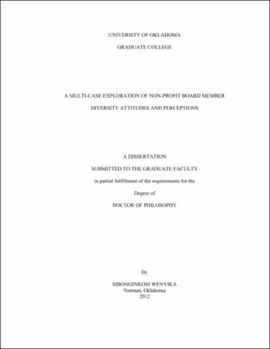| dc.contributor.advisor | Bass, Dr. Lisa | |
| dc.creator | Wenyika, Sibonginkosi | |
| dc.date.accessioned | 2019-04-27T21:31:01Z | |
| dc.date.available | 2019-04-27T21:31:01Z | |
| dc.date.issued | 2012 | |
| dc.identifier | 99261838002042 | |
| dc.identifier.uri | https://hdl.handle.net/11244/318889 | |
| dc.description.abstract | Title of Study: A Multi-Case Exploration of Non-Profit Board Member Diversity | |
| dc.description.abstract | Attitude and Perceptions | |
| dc.description.abstract | Name: Sibonginkosi Wenyika Date: May 2012 | |
| dc.description.abstract | Introduction | |
| dc.description.abstract | Diversity is increasing exponentially in the United States. For example, according to the U.S. Census Bureau (2011) both the Latino and Asian populations have grown by 43% between 2000 and 2010. According to the available literature on diversity, the dramatic and dynamic shift in demographics has consequences on communities, organizations and the American workforce. This is of particular interest to human service non-profit organizations (NPOs) whose target constituencies reflect the increased diversity. Unfortunately, little is known about the level of readiness and effectiveness of such NPOs in dealing with increased diversity. Pitts' (2006) Comprehensive Model of Diversity was assumed as the theoretical framework for this study. The model suggested that organization-wide diversity initiatives should be driven by the board, that organizations that do not embrace and embed diversity imperatives throughout their organizational cultures do not maximize their potential or organizational performance. | |
| dc.description.abstract | Purpose and Method of Study | |
| dc.description.abstract | This qualitative multi-case study explored board member attitudes and perceptions of gender and racial/ethnic diversity using an online survey, one-on-one interviews, document analysis, non-participant observation, field notes and journal. Board members from three United Way accredited NPOs were surveyed on whether their attitudes and perceptions of gender and racial/ethnic diversity impact social and political organizational performance as measured by the participation of members from historically marginalized groups. | |
| dc.description.abstract | Results and Conclusions | |
| dc.description.abstract | Six themes emerged from the data analysis namely; diversity mentioned in organizational bylaws or strategic plan, but no plan of action; board members as recruiters; recruiting strategies and orientation; definitions of gender and racial/ethnic diversity; perceived benefits of diversity and challenges to board diversity. The findings of the study were that none of the NPOs had explicit organization-wide diversity imperatives. Though one of the NPOs had a cultural competency plan, however it did not have any impact on board member attitudes, perceptions and practices towards racial/ethnic diversity. NPOs had made strides with gender diversity; however their level of cultural competence regarding racial and ethnic diversity was inadequate. To address this, and as outcome of the study, the researcher makes recommendations and presents a model. | |
| dc.format.extent | 123 pages | |
| dc.format.medium | application.pdf | |
| dc.language | en_US | |
| dc.relation.requires | Adobe Acrobat Reader | |
| dc.subject | Diversity in the workplace--Public opinion | |
| dc.subject | Directors of corporations--Attitudes | |
| dc.subject | Directors of corporations--Recruiting | |
| dc.subject | Boards of directors--Recruiting | |
| dc.subject | Nonprofit organizations--Management | |
| dc.title | A multi-case exploration of non-profit board member diversity attitudes and perceptions | |
| dc.type | text | |
| dc.type | document | |
| dc.thesis.degree | Ph.D. | |
| ou.group | Graduate College | |
